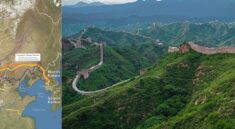The Forbidden City, situated in the heart of Beijing, China, stands as an emblem of China’s imperial past and enduring cultural heritage. With its majestic crimson walls stretching over 180 acres, this architectural marvel served as the imperial palace for nearly 500 years, housing 24 emperors of the Ming and Qing dynasties.
Constructed during the early 15th century under the reign of Emperor Yongle of the Ming Dynasty, the Forbidden City represents the pinnacle of traditional Chinese palace architecture. Its layout, meticulously planned according to ancient Chinese principles of harmony and balance, comprises a series of courtyards, halls, pavilions, and gardens interconnected by a network of grandiose pathways.
About the forbidden city china
The Forbidden City earned its name not from its inaccessibility but rather from the notion that only the emperor, his family, and select court officials could enter its confines. Commoners and foreigners were forbidden entry, adding to the mystique surrounding the palace complex.
As one traverses the Forbidden City, they are greeted by a plethora of architectural wonders, each bearing intricate details and symbolic significance. From the imposing Hall of Supreme Harmony, where imperial ceremonies took place, to the tranquil Imperial Garden, every corner tells a story of China’s rich history and cultural legacy.
Designated as a UNESCO World Heritage Site in 1987, the Forbidden City continues to captivate visitors from around the globe with its grandeur and historical significance. Serving as a symbol of China’s imperial past, it stands as a testament to the country’s enduring cultural heritage and remains a must-visit destination for those seeking to unravel the mysteries of ancient China.
How to get forbidden city beijing china
Getting to the Forbidden City in Beijing, China, is relatively straightforward due to its central location in the capital city. Here’s a guide on how to get there:
- By Public Transportation: Beijing has an extensive public transportation network, including the subway and buses, which offer convenient access to the Forbidden City. You can take the Beijing Subway Line 1 and alight at Tiananmen East or Tiananmen West Station, both of which are within walking distance of the Forbidden City’s southern entrance.
- By Taxi or Ride-Sharing Services: Taxis and ride-sharing services like Didi are widely available in Beijing. You can simply input “Forbidden City” into the app or provide the address (No. 4 Jingshan Front Street, Dongcheng District, Beijing) to the taxi driver to be dropped off at one of the entrances.
- By Bicycle: Beijing has a public bike-sharing system, which allows you to rent bikes from designated stations and cycle to the Forbidden City. There are bike racks available near the entrances where you can securely park your bicycle.
- By Walking: If you’re staying in the nearby area, such as the Wangfujing or Dongcheng district, you can opt to walk to the Forbidden City. It’s a pleasant stroll, especially if you want to explore the surrounding neighborhoods and immerse yourself in the local atmosphere.
Regardless of the mode of transportation you choose, it’s advisable to plan your visit in advance, considering factors such as traffic conditions and the time of day to avoid crowds. Additionally, make sure to have your passport or valid identification handy, as you may be required to present it for security checks when entering the Forbidden City.
Things to do in china the forbidden city
Visiting the Forbidden City in Beijing offers a plethora of activities and experiences that allow you to immerse yourself in China’s rich history and culture. Here are some of the top things to do while exploring this UNESCO World Heritage Site:
- Explore the Palaces and Halls: Wander through the labyrinthine complex of palaces, halls, courtyards, and gardens that make up the Forbidden City. Marvel at the exquisite architecture, intricate designs, and imperial grandeur of structures like the Hall of Supreme Harmony, Hall of Central Harmony, and Palace of Heavenly Purity.
- Learn about Imperial History: Dive into the fascinating history of China’s emperors and dynasties as you explore the various exhibition halls and galleries within the Forbidden City. Admire priceless artifacts, imperial treasures, ancient calligraphy, and royal artifacts that offer insights into the country’s rich cultural heritage.
- Walk the Imperial Gardens: Take a leisurely stroll through the lush Imperial Gardens located at the northern end of the Forbidden City. Admire the meticulously landscaped gardens, tranquil ponds, pavilions, and ancient trees while enjoying scenic views of the surrounding palaces and walls.
- Attend Cultural Performances: Catch traditional Chinese cultural performances, including musical concerts, dance shows, and martial arts demonstrations, held at designated areas within the Forbidden City. These performances offer a glimpse into the ancient arts and traditions of China’s imperial court.
- Visit the Palace Museums: Explore the Palace Museum, which is housed within the Forbidden City complex and features a vast collection of imperial artifacts, artworks, ceramics, and historical documents. Don’t miss the opportunity to visit special exhibitions showcasing various aspects of Chinese history and culture.
- Climb Jingshan Park: After exploring the Forbidden City, ascend Jingshan Park, located just north of the palace complex, for panoramic views of the Forbidden City and Beijing’s skyline. Climb to the top of Jingshan Hill, where the Pavilion of Everlasting Spring offers breathtaking vistas of the surrounding area.
- Enjoy Local Cuisine: Sample delicious traditional Chinese cuisine at one of the restaurants or teahouses located near the Forbidden City. Indulge in classic dishes such as Beijing roast duck, dumplings, and noodles while savoring the flavors of authentic Chinese cooking.
Things not to forget while visiting forbidden city in China
When visiting the Forbidden City in Beijing, there are several essential items you shouldn’t forget to ensure a comfortable and enjoyable experience:
- Valid Identification: Carry your passport or another form of valid identification with you. You may need it for security checks when entering the Forbidden City.
- Comfortable Footwear: Wear comfortable shoes suitable for walking and exploring the vast palace complex. The Forbidden City has extensive pathways and courtyards, so comfortable footwear is essential to prevent fatigue.
- Weather-Appropriate Clothing: Check the weather forecast before your visit and dress accordingly. Beijing experiences distinct seasons, so layering clothing is advisable, especially during spring and autumn when temperatures can vary throughout the day.
- Sun Protection: Bring sunscreen, sunglasses, and a wide-brimmed hat to protect yourself from the sun, particularly during the warmer months. Some areas of the Forbidden City are exposed to direct sunlight, so sun protection is essential.
- Water and Snacks: Stay hydrated by carrying a refillable water bottle with you. While there are vendors and cafes within the Forbidden City, having water and snacks on hand can be convenient, especially during peak visiting hours when lines may be long.
- Camera or Smartphone: Capture memories of your visit by bringing a camera or smartphone with you. The Forbidden City offers numerous picturesque photo opportunities, from ornate palaces to tranquil gardens.
- Guidebook or Audio Guide: Consider bringing a guidebook or downloading an audio guide app to learn more about the history, architecture, and significance of the Forbidden City as you explore.
- Portable Charger: Ensure your electronic devices stay charged throughout your visit by bringing a portable charger or power bank.
- Respectful Attire: Dress modestly and respectfully when visiting the Forbidden City. Avoid clothing that is too revealing or inappropriate for a cultural site.
- Patience and Respect: Finally, remember to be patient and respectful toward other visitors, staff, and the cultural heritage of the Forbidden City. It’s a place of historical significance and reverence for many, so maintaining a respectful attitude enhances everyone’s experience.
Best time to visit
The best time to visit the Forbidden City in Beijing largely depends on your preferences regarding weather, crowds, and special events. Here are some considerations for each season:
- Spring (March to May):
- Spring offers mild temperatures and blooming flowers, making it a pleasant time to visit.
- However, be prepared for occasional dust storms and fluctuating temperatures.
- March and April are relatively less crowded compared to May, which sees an increase in tourist numbers, especially during the Labor Day holiday (May 1st to 3rd).
- Summer (June to August):
- Summer can be hot and humid in Beijing, with temperatures often exceeding 30°C (86°F).
- Despite the heat, summer is peak tourist season, so expect larger crowds and longer wait times for entry.
- Consider visiting early in the morning or late in the afternoon to avoid the midday heat and crowds.
- Autumn (September to November):
- Autumn is arguably the best time to visit the Forbidden City, with mild temperatures, clear skies, and vibrant foliage.
- September and October offer comfortable weather and fewer crowds compared to summer.
- October 1st to 7th is China’s National Day holiday, resulting in increased domestic tourism and crowds.
- Winter (December to February):
- Winter brings cold temperatures and occasional snowfall to Beijing, but the Forbidden City’s snow-covered roofs can create a picturesque scene.
- December and January are the coldest months, with temperatures often dropping below freezing.
- While crowds are significantly smaller during winter, some outdoor areas may be closed or less accessible due to weather conditions.
Considering these factors, the ideal time to visit the Forbidden City is generally during the spring or autumn months when the weather is mild, and there are fewer crowds compared to the peak summer season. However, if you don’t mind the cold or are looking for a quieter experience, winter can also be a viable option. Ultimately, choose a time that aligns with your preferences and priorities for your visit.
Why is Peking a Forbidden City?
The term “Forbidden City” refers to the imperial palace complex in Beijing, China, which served as the residence of Chinese emperors for nearly 500 years during the Ming and Qing dynasties. It earned its name not because it was forbidden to the emperors themselves, but because access to the complex was restricted to the imperial family, their court officials, and selected servants.
The Forbidden City was the political and ceremonial center of Chinese government for centuries. It was surrounded by high walls and a moat, and entry was strictly controlled. Commoners, foreigners, and even high-ranking officials were forbidden from entering the palace without permission.
The reasons for restricting access to the Forbidden City were both practical and symbolic. Practically, it ensured the safety and security of the imperial family and government officials residing within its walls. Symbolically, it reinforced the emperor’s supreme authority and separation from the common people, emphasizing his divine status as the Son of Heaven.
Throughout its history, the Forbidden City was shrouded in mystery and intrigue, with access to its inner workings tightly controlled. This air of exclusivity only added to its allure and fascination, both for the people of China and for visitors from around the world.
Today, the Forbidden City is no longer off-limits to the public. It has been converted into the Palace Museum, attracting millions of visitors each year who come to explore its grand halls, exquisite gardens, and rich history. However, its legacy as a once-forbidden enclave of imperial power continues to captivate imaginations and inspire awe.
What is the Forbidden City in China called?
The Forbidden City in China is called “紫禁城” (Zǐjìnchéng) in Mandarin, which translates to “Purple Forbidden City.” In Chinese, it is also commonly referred to simply as “故宫” (Gùgōng), meaning “Former Palace” or “Palace Museum.”
Why does the Forbidden City have 9999 rooms?
The notion that the Forbidden City has exactly 9,999 rooms is a popular myth rather than a historical fact. In reality, the exact number of rooms in the Forbidden City is difficult to determine precisely due to factors such as changes in usage over time, renovations, and the sheer size of the complex.
The number 9 holds special significance in Chinese culture as it is considered auspicious and represents longevity and eternity. Thus, the idea that the Forbidden City has 9,999 rooms likely originated from a desire to attribute symbolic significance to the palace complex.
While the precise number of rooms may not be known, what is certain is that the Forbidden City is vast, spanning over 180 acres and containing numerous halls, pavilions, courtyards, and other structures. It served as the imperial palace for the Ming and Qing dynasties, accommodating the emperor, his family, and a large retinue of officials, servants, and concubines.
Despite the myth of 9,999 rooms, the Forbidden City remains an architectural marvel and a symbol of China’s imperial past, attracting millions of visitors each year who come to marvel at its grandeur and historical significance.
What is the Forbidden City in China today?
Today, the Forbidden City in China is known as the Palace Museum (故宫博物院 – Gùgōng Bówùyuàn) and serves as one of the most renowned cultural institutions in the country. It is located in the heart of Beijing, occupying a vast complex that was once the imperial palace of China’s Ming and Qing dynasties.
The Palace Museum houses an extensive collection of artifacts, artworks, and cultural treasures that span over 600 years of Chinese history. Visitors to the museum can explore the intricately designed palaces, halls, courtyards, and gardens that make up the Forbidden City, gaining insight into the lives of China’s emperors and the imperial court.
The museum’s collection includes ancient paintings, calligraphy, ceramics, jade, furniture, imperial robes, and other artifacts of historical and artistic significance. Some of the most famous pieces in the collection include the jadeite cabbage, the Qianlong Emperor’s jade seal, and the Yongle Encyclopedia.
As one of China’s most iconic landmarks and a UNESCO World Heritage Site, the Palace Museum attracts millions of visitors from around the world each year. Its role as a cultural institution is not only to preserve and showcase China’s rich heritage but also to educate and inspire future generations about the country’s imperial past and artistic achievements.
Image credits: simple.wikipedia.org, wildgreatwall.com





